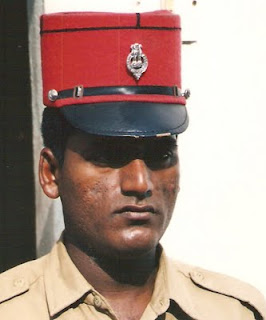
Sources of stress in police personnel
There is conflicting evidence as to the extent to which police constitute a high risk group for suicide. A study of well-being in police at Bangalore showed they were were better adjusted and had a better quality of life than comparable middle class urban factory workers (Geetha 1998). However, they had poorer social contact and support beyond the immediate family. This was attributed to their long working hours, requirement to be on duty during holidays, and the prevalent negative attitude of the public towards the police in general. Traffic policemen, personnel with higher education, and freshly recruited personnel were found to be under greater stress.Police suicides are an interaction of personal vulnerabilities, workplace stressors, and environmental factors as is seen with other worker groups. Two risk factors have been consistently delineated for suicide by police personnel; workplace trauma that increases vulnerability to posttraumatic stress disorders and organisational stressors that lead to burnout. Mental health interventions and organisational change are usually implemented to mitigate these factors. However, little attention is paid to the third leg of police suicide - personal factors (Stuart 2008). Personal factors had a major role to play in the Pune police suicides.
Suicide rates in police
Data on suicide rates for police in India is not available. However, the suicide rate in Pune is more than the national average. This rate is still increasing and is 17.3/100000 as of 2009.Suicide rates in police personnel vary depending on geography. They can be higher than the general population as in Germany (25/100000 vs 20/100000), the same as the general population as in the US (14.9/100000) or half that of the comparable general population as in Canada (14.1/100000).
Suicide rates in police personnel also vary when calculated over long or short time frames, indicating the influence of clustering. This underlines the need for using longer time frames while studying this population (Loo 2003). A historical survey of police suicide from 1843-1992 in Queensland showed the rates reduced from 60/100000 to 20/100000 (Cantor 1995).
The accuracy and validity of police suicide rates are controversial. Under reporting of police suicide is significant (Violanti 2010). Up to 17% of police deaths in the US are classified as undetermined as compared to 8% for military deaths. Official police suicide rates are less accurate and less valid than suicide rates published for other working populations (Violanti 1996). We have already discussed the reasons and results of underestimating suicide rates in India.
What needs to be done
- Personal factors that contribute to suicide need special attention. These factors play alongside the workplace and environmental stressors in police personnel. These include psychiatric illnesses, alcoholism, physical ill health and interpersonal and marital problems. These problems are similar to those of the general population.
- An early warning system for stressful police events needs to be implemented. The LEOSS (Law Enforcement Officer Stress Survey) is a short 25-item questionnaire specifically designed to evaluate stress in police personnel (Van Hasselt 2003).
- Police personnel need easy access to mental health services. The barriers are formidable; psychiatric evaluation can result in job sanctions, reassignment, restriction of firearm privileges, missed promotions, and stigmatisation (Mazurk 2002).
Need for more organisational change?
References
- Cantor CH, Tyman R, Slater PJ. A historical survey of police suicide in Queensland, Australia, 1843-1992. Suicide Life Threat Behav. 1995 Winter;25(4):499-507.
- Geetha PR, Subbakrishna DK, Channabasavanna SM. Subjecitive well being among police personnel. Indian J. Psychiat., 1998, 40(2), 172-179
- Loo R. A meta-analysis of police suicide rates: findings and issues. Suicide Life Threat Behav. 2003 Fall;33(3):313-25.
- Marzuk PM, Nock MK, Leon AC, Portera L, Tardiff K. Suicide among New York City police officers, 1977-1996. Am J Psychiatry. 2002 Dec;159(12):2069-71.
- Stuart H. Suicidality among police. Curr Opin Psychiatry. 2008 Sep;21(5):505-9.
- Van Hasselt VB, Sheehan DC, Sellers AH, Baker MT, Feiner CA. A behavioral-analytic model for assessing stress in police officers: phase I. Development of the Law Enforcement Officer Stress Survey (LEOSS). Int J Emerg Ment Health. 2003 Spring;5(2):77-84.
- Violanti JM, Vena JE, Marshall JR, Petralia S. A comparative evaluation of police suicide rate validity. Suicide Life Threat Behav. 1996 Spring;26(1):79-85.
- Violanti JM. Suicide or undetermined? A national assessment of police suicide death classification. Int J Emerg Ment Health. 2010 Spring;12(2):89-94.